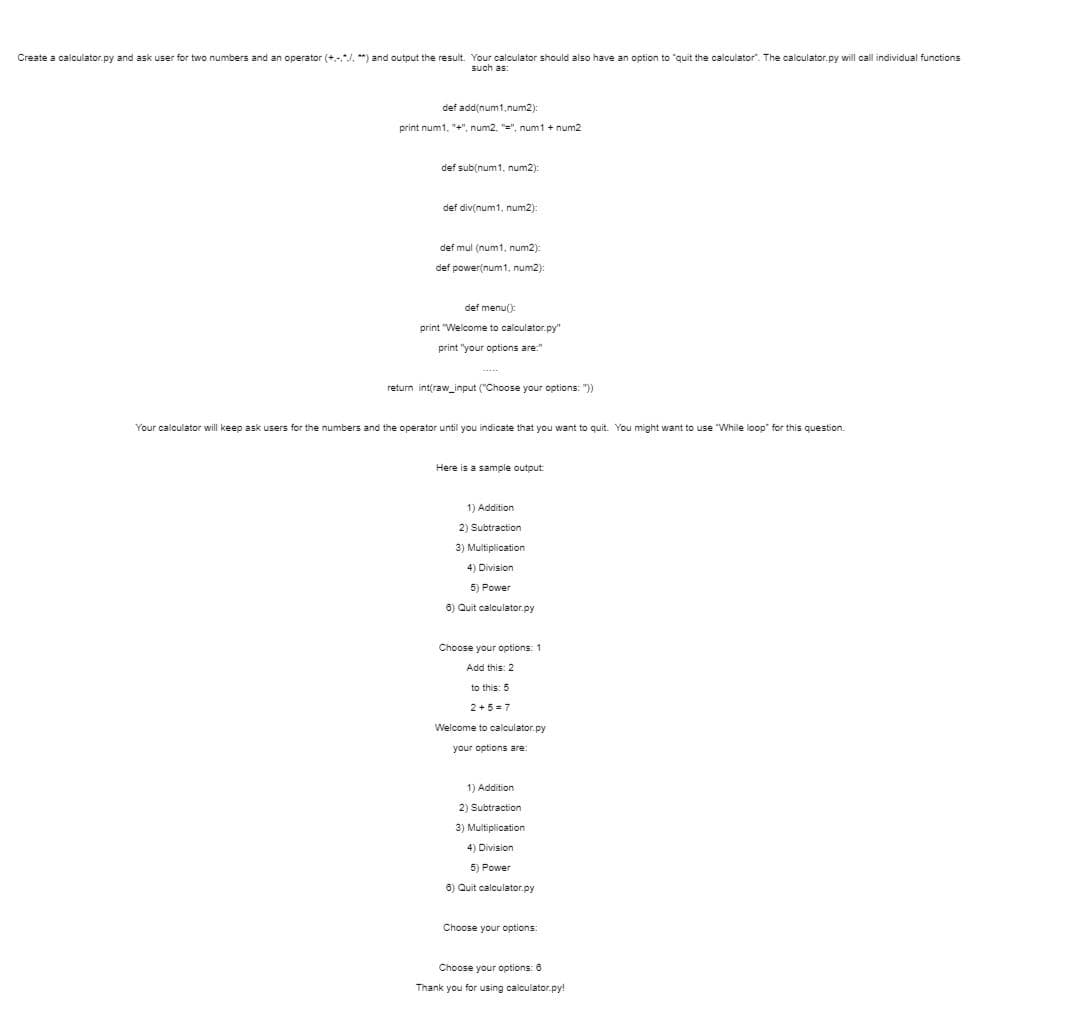Create a calculator.py and ask user for two numbers and an operator (+.-J. ) and output the result. Your calculator should also have an option to "quit the calculator. The calculator.py will call individual functions such as: def add(num1.num2): print num1. "+". num2. =", num 1 + num2 def sub(num1, num2): def div(num1, num2): def mul (num1, num2): def power(num1, num2): def menu(): print "Welcome to calculator.py" print "your options are" return int(raw_input ("Choose your options: ")) Your calculator will keep ask users for the numbers and the operator until you indicate that you want to quit. You might want to use "While loop" for this question. Here is a sample output 1) Addition 2) Subtraction 3) Multiplication 4) Division 5) Power 6) Quit calculator.py Choose your options: 1 Add this: 2 to this: 5 2+5 = 7 Welcome to calculator.py your options are: 1) Addition 2) Subtraction 3) Multiplication 4) Division 5) Power 6) Quit calculator.py Choose your options: Choose your options: 6 Thank you for using calculator.py!
Create a calculator.py and ask user for two numbers and an operator (+.-J. ) and output the result. Your calculator should also have an option to "quit the calculator. The calculator.py will call individual functions such as: def add(num1.num2): print num1. "+". num2. =", num 1 + num2 def sub(num1, num2): def div(num1, num2): def mul (num1, num2): def power(num1, num2): def menu(): print "Welcome to calculator.py" print "your options are" return int(raw_input ("Choose your options: ")) Your calculator will keep ask users for the numbers and the operator until you indicate that you want to quit. You might want to use "While loop" for this question. Here is a sample output 1) Addition 2) Subtraction 3) Multiplication 4) Division 5) Power 6) Quit calculator.py Choose your options: 1 Add this: 2 to this: 5 2+5 = 7 Welcome to calculator.py your options are: 1) Addition 2) Subtraction 3) Multiplication 4) Division 5) Power 6) Quit calculator.py Choose your options: Choose your options: 6 Thank you for using calculator.py!
Computer Networking: A Top-Down Approach (7th Edition)
7th Edition
ISBN:9780133594140
Author:James Kurose, Keith Ross
Publisher:James Kurose, Keith Ross
Chapter1: Computer Networks And The Internet
Section: Chapter Questions
Problem R1RQ: What is the difference between a host and an end system? List several different types of end...
Related questions
Question
#

Transcribed Image Text:Create a calculator.py and ask user for two numbers and an operator (+-*, **) and output the result. Your calculator should also have an option to "quit the calculator". The calculator.py will call individual functions
such as
def add(num1.num2):
print num1, "+", num2, "=", num1 + num2
def sub(num1, num2):
def div(num1, num2)
def mul (num1, num2):
def power(num 1, num2):
def menu():
print "Welcome to calculator.py"
print "your options are:"
return int(raw_input ("Choose your options: "))
Your calculator will keep ask users for the numbers and the operator until you indicate that you want to quit. You might want to use "While loop" for this question.
Here is a sample output
1) Addition
2) Subtraction
3) Multiplication
4) Division
5) Power
6) Quit calculator.py
Choose your options: 1
Add this: 2
to this: 5
2+5 = 7
Welcome to calculator.py
your options are
1) Addition
2) Subtraction
3) Multiplication
4) Division
5) Power
6) Quit calculator.py
Choose your options:
Choose your options: 6
Thank you for using calculator.py!
Expert Solution
This question has been solved!
Explore an expertly crafted, step-by-step solution for a thorough understanding of key concepts.
Step by step
Solved in 2 steps with 3 images

Recommended textbooks for you

Computer Networking: A Top-Down Approach (7th Edi…
Computer Engineering
ISBN:
9780133594140
Author:
James Kurose, Keith Ross
Publisher:
PEARSON

Computer Organization and Design MIPS Edition, Fi…
Computer Engineering
ISBN:
9780124077263
Author:
David A. Patterson, John L. Hennessy
Publisher:
Elsevier Science

Network+ Guide to Networks (MindTap Course List)
Computer Engineering
ISBN:
9781337569330
Author:
Jill West, Tamara Dean, Jean Andrews
Publisher:
Cengage Learning

Computer Networking: A Top-Down Approach (7th Edi…
Computer Engineering
ISBN:
9780133594140
Author:
James Kurose, Keith Ross
Publisher:
PEARSON

Computer Organization and Design MIPS Edition, Fi…
Computer Engineering
ISBN:
9780124077263
Author:
David A. Patterson, John L. Hennessy
Publisher:
Elsevier Science

Network+ Guide to Networks (MindTap Course List)
Computer Engineering
ISBN:
9781337569330
Author:
Jill West, Tamara Dean, Jean Andrews
Publisher:
Cengage Learning

Concepts of Database Management
Computer Engineering
ISBN:
9781337093422
Author:
Joy L. Starks, Philip J. Pratt, Mary Z. Last
Publisher:
Cengage Learning

Prelude to Programming
Computer Engineering
ISBN:
9780133750423
Author:
VENIT, Stewart
Publisher:
Pearson Education

Sc Business Data Communications and Networking, T…
Computer Engineering
ISBN:
9781119368830
Author:
FITZGERALD
Publisher:
WILEY